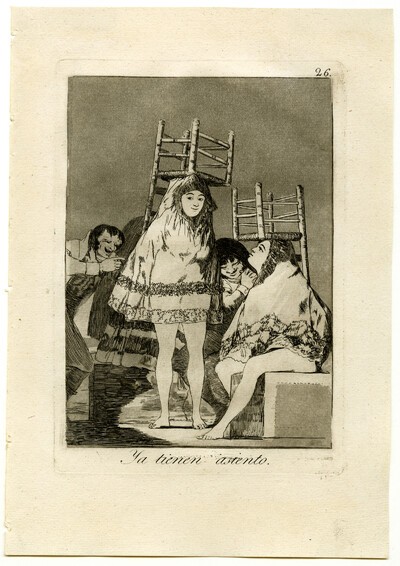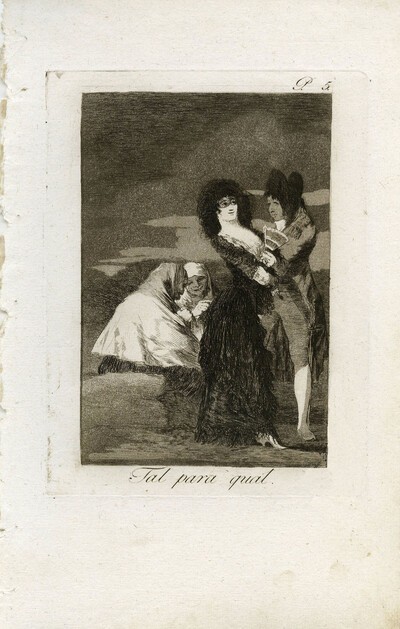- Cronología
- Ca. 1797
- Ubicación
- The Prado National Museum. Madrid, Madrid, Spain
- Dimensiones
- 204 x 145 mm
- Técnica y soporte
- Reconocimiento de la autoría de Goya
- Documented work
- Titular
- El Prado National Museum
- Ficha: realización/revisión
- 20 Aug 2021 / 19 Apr 2023
- Inventario
- D3940
11 (in pencil, recto, lower left-hand corner)
50 (in pencil, recto, lower right-hand corner)
Watermark: [Shield crowned with the monogram "MA" and the letter "SOLE"] (lower half)
The drawing passed by inheritance in 1828 to Javier Goya, the painter's son, and in 1854 to Mariano Goya y Goicoechea, the artist's grandson. It was subsequently owned by Valentín Carderera (ca. 1861) and Mariano Carderera (ca. 1880). In 1886 it was acquired from Mariano Carderera by the General Direction of Public Instruction and was assigned to the Prado Museum, where it entered on 12 November 1886.
This drawing, which was transferred to the plate but was not finally engraved, can be related to Capriche 26. They already have a seat.
Just like that.In both cases the grotesque use of clothing on the main figures is the link between them. While in Caprice 26 young women are depicted with petticoats on their heads, in the present drawing a man in the centre of the composition wears breeches instead of a jacket, which he wears as a skirt. He wears shoes with buckles over his ears, as does the small figure in front of him. Her left hand rests on a brazier as a walking stick, while with her right she is trying to make a sign to the figure in front of her, who, like the prostitutes in Whim 26, is wearing a petticoat over her head. According to Wilson-Bareau, both figures dressed upside down express an ambiguous sexuality. The direct gaze between them suggests an unclear relationship. Behind them, the figures of two women looking and laughing are reminiscent of the old men and women in Caprice 26 and those in Caprice 5. Just like that.
It is a magnificently finished drawing which, however, was never engraved, perhaps because of the implications of the subject in Goya's time, who finally decided to exclude it from the Caprices series.
-
Europa 1789. Aufklärung, Verklärung, VerfallHamburger KunsthalleHamburg1989
-
Goya. La década de Los CaprichosMadrid1992organized by Real Academia de Bellas Artes de San Fernando sponsored by Fundación Central Hispano, Madrid, consultant editor Nigel Glendinnig. From October 26th 1992 to January 10th 1993cat. 144
-
Madrid2007cat. 19
-
BarcelonaLabor1925nº 95, il. 346.
-
MadridMuseo del Prado1954n. 195
-
Vie et ouvre de Francisco de GoyaParísOffice du livre1970p. 186, cat. 629
-
Dibujos de Goya, 2 volsBarcelonaNoguer1975p. 170, cat. 133
-
ZaragozaCaja de Ahorros de Zaragoza, Aragón y Rioja1980-1982p. 96
-
La década de los Caprichos. Retratos 1792-1804MadridReal Academia de Bellas Artes de San Fernando1992pp. 240-241, cat. 144


